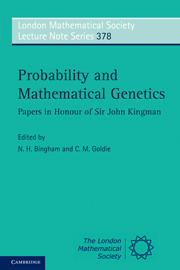Refine search
Actions for selected content:
3023 results in Probability theory and stochastic processes
17 - Processes with jumps
-
- Book:
- Stochastic Processes
- Published online:
- 05 June 2012
- Print publication:
- 06 October 2011, pp 130-146
-
- Chapter
- Export citation
14 - Local times
-
- Book:
- Stochastic Processes
- Published online:
- 05 June 2012
- Print publication:
- 06 October 2011, pp 94-99
-
- Chapter
- Export citation
Frequently used notation
-
- Book:
- Stochastic Processes
- Published online:
- 05 June 2012
- Print publication:
- 06 October 2011, pp xv-xvi
-
- Chapter
- Export citation
2 - Brownian motion
-
- Book:
- Stochastic Processes
- Published online:
- 05 June 2012
- Print publication:
- 06 October 2011, pp 6-12
-
- Chapter
- Export citation
42 - Lévy processes
-
- Book:
- Stochastic Processes
- Published online:
- 05 June 2012
- Print publication:
- 06 October 2011, pp 339-347
-
- Chapter
- Export citation
37 - Infinitesimal generators
-
- Book:
- Stochastic Processes
- Published online:
- 05 June 2012
- Print publication:
- 06 October 2011, pp 286-301
-
- Chapter
- Export citation
6 - Construction of Brownian motion
-
- Book:
- Stochastic Processes
- Published online:
- 05 June 2012
- Print publication:
- 06 October 2011, pp 36-42
-
- Chapter
- Export citation
31 - Skorokhod representation
-
- Book:
- Stochastic Processes
- Published online:
- 05 June 2012
- Print publication:
- 06 October 2011, pp 244-246
-
- Chapter
- Export citation
18 - Poisson point processes
-
- Book:
- Stochastic Processes
- Published online:
- 05 June 2012
- Print publication:
- 06 October 2011, pp 147-151
-
- Chapter
- Export citation
5 - The Poisson process
-
- Book:
- Stochastic Processes
- Published online:
- 05 June 2012
- Print publication:
- 06 October 2011, pp 32-35
-
- Chapter
- Export citation
D - Kolmogorov extension theorem
- from Appendices
-
- Book:
- Stochastic Processes
- Published online:
- 05 June 2012
- Print publication:
- 06 October 2011, pp 382-384
-
- Chapter
- Export citation
28 - Financial mathematics
-
- Book:
- Stochastic Processes
- Published online:
- 05 June 2012
- Print publication:
- 06 October 2011, pp 218-228
-
- Chapter
- Export citation
12 - Some applications of Itô's formula
-
- Book:
- Stochastic Processes
- Published online:
- 05 June 2012
- Print publication:
- 06 October 2011, pp 77-88
-
- Chapter
- Export citation
35 - Applications of weak convergence
-
- Book:
- Stochastic Processes
- Published online:
- 05 June 2012
- Print publication:
- 06 October 2011, pp 269-278
-
- Chapter
- Export citation
27 - Brownian excursions
-
- Book:
- Stochastic Processes
- Published online:
- 05 June 2012
- Print publication:
- 06 October 2011, pp 214-217
-
- Chapter
- Export citation

Probability and Mathematical Genetics
- Papers in Honour of Sir John Kingman
-
- Published online:
- 07 September 2011
- Print publication:
- 15 July 2010
Frontmatter
-
- Book:
- Random Fields on the Sphere
- Published online:
- 07 October 2011
- Print publication:
- 25 August 2011, pp i-vi
-
- Chapter
- Export citation
11 - Needlets Estimation of Power Spectrum and Bispectrum
-
- Book:
- Random Fields on the Sphere
- Published online:
- 07 October 2011
- Print publication:
- 25 August 2011, pp 265-281
-
- Chapter
- Export citation
5 - Spectral Representations
-
- Book:
- Random Fields on the Sphere
- Published online:
- 07 October 2011
- Print publication:
- 25 August 2011, pp 114-133
-
- Chapter
- Export citation
3 - Representations of SO(3) and Harmonic Analysis on S2
-
- Book:
- Random Fields on the Sphere
- Published online:
- 07 October 2011
- Print publication:
- 25 August 2011, pp 45-84
-
- Chapter
- Export citation
